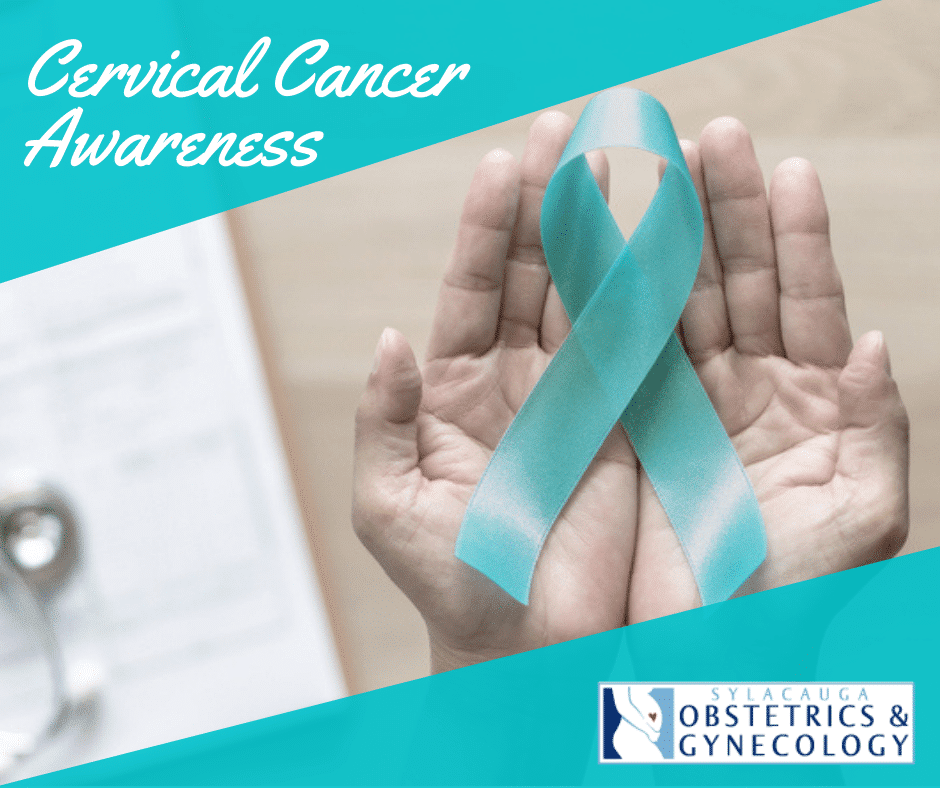
09 Dec Do You Need to Schedule A Screening Appointment? Cervical Cancer Awareness
Just as we saw regular mammogram appointments drop off over the last couple of years due to the coronavirus pandemic, annual appointments for other types of cancer screenings have decreased as well. These appointments are incredibly important though, and we challenge anyone who has put it off in recent months to add this to your to-do list for the beginning of 2022.
In particular, we want to make screening for cervical cancer a priority since January is Cervical Cancer Awareness Month. Cervical cancer can often be found early, and sometimes even prevented, by having regular screening tests. If detected early, cervical cancer is one of the most successfully treatable cancers.
What Is Cervical Cancer?
Cervical cancer starts in the cells lining the cervix, which is the lower part of the uterus. The cervix connects the body of the uterus (the upper part where a fetus grows) to the vagina (birth canal). Cancer starts when cells in the body mutate and begin to grow out of control.
The cervix is made of two parts and is covered with two different types of cells:
- The endocervix is the opening of the cervix that leads into the uterus. It is covered with glandular cells.
- The exocervix (or ectocervix) is the outer part of the cervix that can be seen by the doctor during a speculum exam. It is covered in squamous cells.
The place where these two cell types meet in the cervix is called the transformation zone. The exact location of the transformation zone changes as you get older and if you give birth. Most cervical cancers begin in the cells in the transformation zone.
Cells in this zone do not suddenly change into cancer. Instead, normal cells of the cervix first gradually develop abnormal changes that are pre-cancerous.
How Do We Screen For Cervical Cancer?
The American Cancer Society’s estimates for cervical cancer in the United States for 2021 are:
- About 14,480 new cases of invasive cervical cancer will be diagnosed.
- About 4,290 women will die from cervical cancer.
Cervical cancer was once one of the most common causes of cancer death for American women. The cervical cancer death rate dropped significantly with the increased use of the Pap test.
In recent years, the HPV test has been approved as another screening test for cervical cancer since almost all cervical cancers are caused by HPV (human papillomavirus). The HPV test looks for infection of high-risk types of HPV that are more likely to cause pre-cancers and cancers of the cervix. The HPV test can be used alone (primary HPV test) or at the same time as the Pap test (called a co-test).
Cervical cancer is most frequently diagnosed in women between the ages of 35 and 44, andthe average age at diagnosis is 50. This type of cancer rarely develops in women younger than 20. Many older women do not realize that the risk of developing cervical cancer is still present as they age, which contributes to the fact that more than 20% of cases of cervical cancer are found in women over 65. However, these cancers rarely occur in women who have been getting regular tests to screen for cervical cancer before they were 65.
The goal of cervical cancer screening is to find pre-cancer or cancer early when it is more treatable and curable. Regular screening can prevent cervical cancers and save lives.
Risk Factors for Cervical Cancer
Several risk factors can increase your chance of developing cervical cancer. Women without any of these risk factors rarely develop the disease.
Cervical cancer may run in some families. If your mother or sister had cervical cancer, your chances of developing the disease are higher than if no one in the family had it. Some researchers suspect that rare instances of this familial tendency are caused by an inherited condition that makes some women less able to fight off the HPV infection.
While you can’t change your family history, you can focus on things you can change, such as smoking and other risk factors listed below. For women who have any type of risk factor, it’s even more important to have regular screening tests to look for cervical cancer early.
Risk factors for cervical cancer:
HPV infection
HPV is a group of more than 150 related viruses, and an infection is a significant risk factor for cervical cancer. HPV can infect cells on the surface of the skin and those lining the genitals, anus, mouth, and throat, but not the blood or internal organs, such as the heart or lungs.
HPV can spread from one person to another during skin-to-skin contact. One way HPV spreads is through sexual activity, including vaginal, anal, and even oral sex.
Infection with HPV is common, and in most people the body can clear the infection with no problem or intervention. Sometimes, however, the infection does not go away and becomes chronic. Chronic infection, especially when it is caused by certain high-risk HPV types, can eventually cause cancer, such as cervical cancer.
Although there is currently no cure for HPV infection, there are ways to treat it. HPV vaccines are available to help prevent infection by certain types of HPV and some of the cancers linked to those types.
Sexual history
Several factors related to your sexual history can increase the risk of cervical cancer. The risk is most likely affected by increasing the chances of exposure to HPV. Becoming sexually active at a young age (especially younger than 18 years old), having many sexual partners, and having one partner who is considered high risk can increase your chances.
Smoking
When someone smokes, they and those around them are exposed to many cancer-causing chemicals that affect organs other than the lungs. These harmful substances are absorbed through the lungs and carried in the bloodstream throughout the body.
Women who smoke are about twice as likely as those who don’t smoke to get cervical cancer. Tobacco by-products have been found in the cervical mucus of women who smoke. Researchers believe that these substances damage the DNA of cervix cells and may contribute to the development of cervical cancer. Smoking also makes the immune system less effective in fighting HPV infections.
Having a weakened immune system
Human immunodeficiency virus (HIV), the virus that causes AIDS, weakens the immune system and puts people at higher risk for HPV infections. The immune system is important in destroying cancer cells and slowing their growth and spread. In women with HIV, a cervical pre-cancer might develop into an invasive cancer faster than it normally would.
Another group of women at risk for cervical cancer are those taking drugs to suppress their immune response, such as those being treated for an autoimmune disease (in which the immune system sees the body’s own tissues as foreign and attacks them, as it would a germ) or those who have had an organ transplant.
Chlamydia infection
Chlamydia is a relatively common kind of bacteria that can infect the reproductive system. It is spread by sexual contact. Women who are infected with chlamydia often have no symptoms, and they may not know that they are infected at all unless they are tested during a pelvic exam. Chlamydia infection can cause pelvic inflammation, leading to infertility.
Some studies have seen a higher risk of cervical cancer in women whose blood tests and cervical mucus showed evidence of past or current chlamydia infection. Certain studies also show that the chlamydia bacteria may help HPV grow and live on in the cervix which may increase the risk of cervical cancer.
Long-term use of oral contraceptives (birth control pills)
There is evidence that taking oral contraceptives (OCs) for a long time increases the risk of cancer of the cervix. Research suggests that the risk of cervical cancer goes up the longer a woman takes OCs, but the risk goes back down again after the OCs are stopped, and returns to normal many years after stopping. We are happy to talk with you more about the benefits of OCs vs. the potential risks.
Schedule Your Cervical Cancer Screening Appointment!
The two most important things you can do to prevent cervical cancer are to get the HPV vaccine if you are eligible and be tested regularly through an annual exam at Sylacauga OB-GYN. Don’t put it off any longer. If you have questions about the HPV vaccine and other aspects of cervical cancer screening, let us know!
LEARN MORE ABOUT WHAT MAKES SYLACAUGA OBSTETRICS AND GYNECOLOGY A TOP PROVIDER
Sylacauga OB-GYN is the premier provider of obstetric and gynecological services in Sylacauga, Alexander City, Talladega, and the surrounding areas. From your first exam to your new little one’s delivery, our staff and providers are here to make your journey as smooth as possible. At Sylacauga Obstetrics & Gynecology, we are ready to answer your questions, provide support, and guide your process during your baby’s growth!
No need to drive to Birmingham to receive a superior quality of care for you and your impending bundle of joy. We are big town doctors with small-town care! Check out our website or give us a call at 256-487-9346 for more information or to schedule an appointment. For more information about healthy pregnancies, delivery options, and more, give us a call or email us at [email protected].


